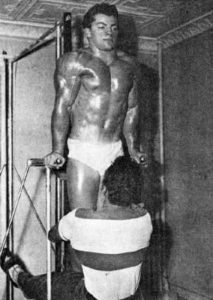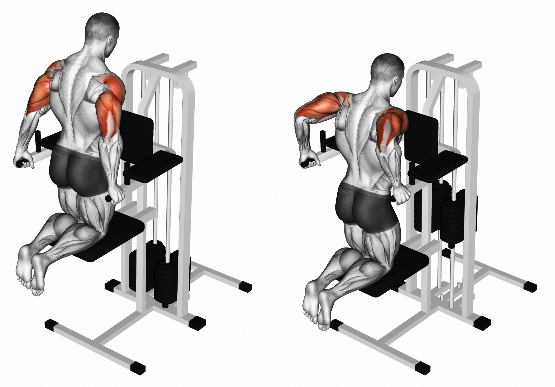Don't Forget Dips | Squats for the Upper Body
Published: Mon, 10/17/22

I started doing dips to strengthen and build my triceps and pecs in 1965. I was an avid reader of Strength & Health magazine, the bible of American Olympic lifting. Staff writers John McCallum, Bill Starr and Tommy Suggs all championed parallel bar dips, no weight and weighted. McCallum called dips, “Squats for the upper body.” This analogy is accurate on a multitude of levels.
Anyone in the strength world knows that barbell squats are the undisputed King of all progressive resistance exercises – for reasons best discussed another time. Comparing dips to squats is the ultimate compliment for dips. Physiologically, squats and dips have a lot of commonalities: both dips and squats require the upper arm or upper leg be eccentrically lowered to a point “below parallel” (to the floor) before arising concentrically.
McCallum suggested that dips are the ultimate triceps exercise. He might be right. I think a strong case could be made that weighted dips (done using a highly specific technique) are indeed the best tricep exercise. My other top tricep contenders would be narrow-grip bench presses, nose-breakers with an EZ-curl bar and overhead tricep press with two arms using a single dumbbell.
McCallum pointed out that dips taken too deep cause the pectorals to become involved. There is also undue rotator cuff stress with ultra-low dips. Our objection with deep dips is that the poundage needs to be reduced to a significant degree and while the reduced payload is more than enough to stress the pecs, the reduced payload is insufficient to really stress the triceps. Why turn one of the world’s best tricep exercises into a subpar pec exercise?
I started doing dips after reading a blurb in a Strength & Health gossip column that related that all the top York Olympic weightlifters were performing weighted dips for 3-5 rep sets to improve their overhead pressing: the press was still an Olympic lift. The column noted that all the dipping lifters had cut the sleeves off their sweatshirts to show off their newly bulging triceps. I wanted me some of that. I wanted a bigger overhead press and bulging
triceps. Since I had no dip bars, I had to improvise.
We had a set of sturdy steps leading down from the kitchen into the unfinished basement. I positioned a wooden step ladder (opened) adjacent to the descending stairsteps. By placing a short section of two x four board atop the ladder I created one dip handhold. The other handhold was a basement step now the same height. I would step up onto the ladder, place my right hand on the board atop the ladder and use the edge of a basement step as my left handhold. I would
step off into the space between the step ladder and the step. I would start in the locked-out position and lower down to slightly below parallel before pushing erect.
It took me six-weeks to work up to 20 reps in the no-weight dip. At that point we (my training partners and I) strapped on weight. I had a pair of iron ‘weight boots’ that came with an ancient barbell set. No one used them. They weighed 5 pounds and had a long canvas strap for affixing the iron boots to the calves, Roman sandal style. We used the strap to tie the iron boots to our waist. Each iron boot had a hole through the sole to slide a dumbbell. As we got stronger, we’d add a dumbbell to the iron boot dip apparatus.
One of the greatest compliments I have ever gotten in my life occurred when I had to undergo a physical exam before being allowed to play football. This particular doctor saw a lot of athletes on a regular basis. When I stripped off my shirt he exclaimed, “Good God!” his eyes bugged. “The backs of your arms are swollen – did you get bit by a spider?” He started prodding them. “Are you allergic to bee stings? Did you get stung?” He was serious and concerned until I flexed them and yawned. Weighted dips, done right, are the Mac Daddy of tricep exercises.
One important technical point: because our dips were done off a stairstep and a step ladder, our hands were turned sideways. In a regular dip done on regular dip apparatus, the hand is placed so the thumb is forward. In our version, we dipped with our hands held sideways, just as the hands are held when pressing a barbell overhead or during a barbell bench press. I am convinced that this sideways hand position made our dips more applicable to
overhead pressing and bench pressing than the standard thumb-to-the-front dip technique.

It makes sense to perform dips at the end of a flat bench or overhead press training session. Never dip before any type of pressing for you will surely ruin your pressing power for that day. It also makes sense to master weightless, or "bodyweight", dips before attempting weighted dips. Unless you can perform 12-15 no weight dips, you haven’t earned the right to perform weighted dips. The classical weighted dip strategy would be to warm up with a
no-weight set of 10 reps. At that point start strapping on small poundage. A couple sets of progressively heavier weighted dips are followed with a final, rep-till-failure set with no weight. Five rep sets are ideal for weighted dips.
Make haste slowly in weighted dips. The biggest mistake is allowing ego to enter into the equation: guys want to be seen dipping with a 45 pound weight plate strapped to the waist when a 25 pound plate, dipped deeper, would kick their ass. The ego dipper starts cutting the dip depth so they can handle the big poundage. Shallow dips, like shallow squats, are worthless. Accountants have a saying about taxes; paying too little is illegal and paying too much is stupid. Ditto dip depth: too shallow is worthless and too deep is potentially injurious.
Give dips a try. With todays modern equipment anyone can learn how to incorporate dips into their training. The advent of the assisted dip machine can aid even the weakest trainee if proper form is used. Master the no-weight dip first. You MUST emphasize the lockout. Every single dip rep must end in a bone-on-bone lockout, a hard lockout. All the good stuff, insofar as tricep strengthening and development, happens at lockout. 90% of dippers use shallow depth and
a soft lockout. Dip slightly below parallel on each dip and lock each rep out completely. Inhale on the descent and exhale as you approach lockout. Dip once a week after doing heavy pressing. I instinctively super-set (alternate) a set of curls with each and every tricep exercise I do. Why not hit a set of strict bicep curls while waiting around for the triceps to recover for the next dip set?

Let’s get to dipping. If possible, try the hands turned sideways while dipping. Make haste slowly; try hitting a set of curls between dip sets – why not? Stay with it for three months. Dips will up your pressing power, be it flat or overhead and dips will grow your triceps to spider-bite proportion. Check out the training resources below including a YouTube Dip instructional video by clicking on the picture.




If you have any questions please click here. For more information on our training techniques and tactics, click the link below to check out our site!



Thanks
Marty Gallagher
Get Strong! Live Long!
